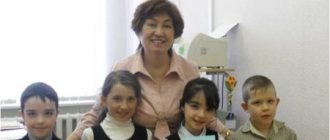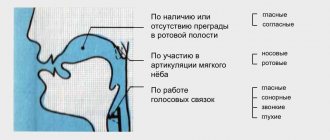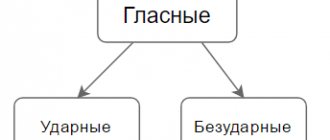Since vowel sounds vary articulatory and acoustically, sound classifications are based on these features. Each vowel sound has its own articulation, allowing it to be distinguished from other phonemes.
The articulatory classification of vowels is based on the fact that they are all characterized by three features:
- The degree of tongue elevation;
- The place where the tongue rises (row);
- Labialization - non-labialization.
Characteristics of vowels in the table
The phonetic transcription system uses all the vowels of the Russian alphabet, except for ya, yu, e, ё, which in Russian graphics denote the same sounds as a, u, e, o after soft consonants or a combination of sounds [ya], [yu] , [ye], [yo]. Thus, each vowel can be determined by a combination of three characteristics inherent in it. For example:
[e] - middle instep, front row, non-labialized, [y] - upper instep, back row, labialized, etc.
In the table, the composition of vowels of the Russian literary language with their characteristics can be presented in the following form:
| Climb | Row | ||
| front | average | rear | |
| Upper | And | s | at |
| Average | uh | O | |
| Lower | A | ||
| Non-labialized | Round | ||
The articulatory classification of vowels is studied in the section of the Russian language - phonetics. In order to pronounce words correctly, you need to know where vowel sounds are formed in the articulation apparatus.
Staging and automation of sound [A].
Staging and automation of sound [A ].
Sound [A ] of the middle row, lower rise.
Articulation is normal when spoken in isolation.
The lips are relaxed, in a free position, and do not participate in articulation (passive). The mouth is open. The distance between the incisors is large, approximately 2 cm. The tongue is passive, lying quietly on the floor of the mouth. The tip is close to the lower incisors. The back is the lower instep. The velum palatine is raised, pressed against the back wall of the pharynx, closing the passage into the nasal cavity - the sound of the mouth. The vocal cords are closed and vibrate – a voice, the sound of the vocal cord, is formed. You can see the position of the lips, the edges of the incisors, partially the position of the tongue, fogging on the mirror, the image on the I-2M device. You can feel the vibration of the larynx and in the chest area, and on the back of the hand - a wide air stream can be heard (III. VI gr.) residual hearing is attracted.
Ways to induce correct articulation: Children become familiar with the sound A in the first lessons. Children see how the teacher pronounces the word, hear how it sounds, repeat it and compare their pronunciation with the teacher’s pronunciation. The teacher gives you the opportunity to feel with your hand the exhaled air, the vibration of the larynx, and in some cases check articulation in front of a mirror.
Stages: 1 ) Selecting a word for analysis (the sound must be stressed). 2) Pronunciation sample. The child perceives the word auditorily - visually. 3) Analysis of the word - divide it into syllables. 4) Divide it into sounds. We work with isolated sound. 5) Synthesis. 6) Phonetic rhythm (breathing, tongue at the lower incisors = voice).
Possible defects
A=E .(pepe). The back of the tongue is raised, the mouth is not open enough (the distance between the incisors has decreased).
A = I. Explain the essence of the defect. Show in front of the mirror that you should keep your tongue flat and not allow it to be pulled deeper into your mouth (show all this on your own articulation). If you cannot give the tongue the required position, lightly press the back of the tongue with a spatula.
A=Y. (pypy), (pyapya) (deep A). Incorrect position of the tongue: the tip of the tongue is pulled very deep (tongue is lumpy).
Elimination: Eliminated in the same way. Like A=E. If it doesn’t work, invite the child to say A, holding the tip of the tongue against the incisors.
A=O . Incorrect lip position.
Elimination: By imitation + articulation exercises.
Open nasality: The velum is lowered. Only lips articulate with almost no voice.
Remedy: Explain the nature of the defect. To do this, involve all intact analyzers (visual, kinesthetic, tactile, motor), with the help of which the child must understand the essence of his mistake. Correction by imitation. Exercises on a firm attack (to say abruptly, with tense articulation) under conducting. The lifting of the velum will occur reflexively. Gradually move to a drawn-out pronunciation (A, A, A, A_________).
www.Logopedy.ru
The articulatory apparatus (active organs of which are the tongue, lips, lower jaw, soft palate; passive organs - teeth, upper jaw, hard palate) and the voice-forming apparatus - vocal folds - take the main part in the formation of sounds.
Classification of sounds according to the absence or presence of an obstruction in the oral cavity:
vowels – [a], [e], [i], [s], [o], [u];
consonants - all the rest.
Classification of sounds according to their participation in the articulation of the soft palate:
nasals – [m], [m'], [n], [n'];
oral - all the rest.
Classification of sounds according to the functioning of the vocal folds:
vowels – [a], [e], [i], [s], [o], [u];
sonorous – [th], [m], [m'], [n], [n'], [l], [l'], [r], [r'];
voiced – [v], [v'], [z], [z'], [g], [b], [b'], [d], [d'], [g], [g'] ;
deaf – [f], [f'], [s], [s'], [sh], [p], [p'], [t], [t'], [k], [k'] , [x], [x'], [h], [sch].
Classification of consonant sounds according to the method of formation:
stop plosives – [p], [p'], [b], [b'], [t], [t'], [d], [d'], [k], [k'], [ g], [g'];
occlusive passages – [m], [m'], [n], [n'], [l], [l'];
fricatives (fricatives) – [f], [f'], [v], [v'], [s], [s'], [z], [z'], [w], [zh], [ ь], [th], [x], [x'];
occlusive fricatives (affricates) – [ts], [h];
trembling (vibrants) – [р], [р'].
Classification of consonant sounds by place of formation:
labiolabial – [p], [p'], [b], [b'], [m], [m'];
labiodental – [f], [f'], [v], [v'];
anterior lingual: tip of the tongue at the top – [t], [d], [n], [l], [l'], [r], [r'], [w], [w], [sch], [h ]; tip of the tongue below – [t'], [d'], [n'], [s], [s'], [z], [z'], [c];
middle language – [th];
back-lingual – [k], [k'], [g], [g'], [x], [x'].
Classification of consonant sounds according to the degree of tension in the middle part of the back of the tongue:
soft – [th], [sch], [h], [t'], [d'], [n'], [b'], [v'], [g'], [s'], [ p'], etc.;
solid – [w], [g], [c], [t], [d], [n], [b], [c], [g], [s], [r], etc.
Classification of vowel sounds according to the degree of elevation of the tongue in the oral cavity:
upper rise – [i], [s], [y];
average rise – [e], [o];
lower rise – [a].
Classification of vowel sounds according to their participation in the articulation of different parts of the tongue:
front vowels – [i], [e];
middle vowels – [s], [a];
back vowels – [u], [o].
Classification of vowel sounds taking into account labialization:
labialized – [o], [y];
non-labialized – [i], [e], [s], [a].
Do you like the article? Tell your friends!
Thus, it is clear that all sounds of the Russian language are interconnected and interdependent. A speech therapist must have a good knowledge of the phonetic system of the native language in order to decide in each individual case where to start and what to rely on when working to form or clarify the pronunciation of any sound.
Basics of speech therapy with sound pronunciation workshop
Ed. T.V. Volosovets. – M.: Academy, 2002.
| If you liked this article, share the link to the article with your friends and acquaintances on social media. networks using this button | If you have your own special opinion about the material presented, leave your comment in the form below |
Social commentary Cackle
Vowels and consonants
The number of speech sounds found in different languages of the world is quite large.
The number of typical sounds (phonemes) ranges from 12 to 80. Despite the different set of sounds in different languages, in all languages of the world there are two types of speech sounds - vowels and consonants. The set of vowel sounds forms vocalism (from the Latin vocalis - vowel) of the phonetic system of a particular language, and the set of consonants forms its consonantism (from the Latin conson?ns, genus consonantis - consonant). The classification of sounds can be based on both acoustic and articulatory features. When dividing sounds into vowels and consonants and their internal classification, both of these characteristics are most often taken into account. Vowels are sounds, during the formation of which in the supraglottic cavities there are no obstacles in the path of the air stream: the stream of exhaled air passes freely through the speech canal. For vowel sounds, the so-called diffuse tension of the muscles of the entire pronunciation apparatus is typical, when all speech organs taking part in sound formation are tense. The degree of tension can change: with greater tension, the pronounced vowel has a clearer character (for example, a stressed vowel in Russian). When characterizing vowels, other features are usually noted: vowels are tonal sounds. They are characterized by the presence of musical tones (voices), which are formed by the work of the vocal cords.
Consonants are sounds, the formation of which in the supraglottic cavities or larynx necessarily creates one or another obstacle to the path of the air stream (in the form of close or even closed speech organs). Consonants are characterized by concentrated muscular tension at the point of formation of the obstruction and a stronger air stream than vowels. In addition, consonant sounds are characterized by the presence of noise that occurs when overcoming an obstacle. The admixture of musical tones (voices) may be greater or lesser.
Acoustic classification of speech sounds
The peculiarities of acoustic classification are that it describes vowels and consonants with the same set of terms. In this case, acoustic classification is based, as a rule, on a binary principle, that is, two-term oppositions. In other words, the application of the binary principle in acoustic classification at each division gives two classes of speech sounds. For example, the sign vocality - non-vocality, based on the presence or absence of a clearly defined formant structure of sound, divides speech sounds into sonorant (from the Latin sonorus - sonorous) and noisy. Sonorant (vocal) consonants include vowels and sonorant consonants [m], [n], [l], [p], [j]. Nonvocal consonants include noisy consonants [b], [p], [d], [t], [g], [k], [v], [f], [z], [s], [zh], [ w], [x], [ts], [h]. Sonorant sounds are characterized by the presence of resonator tones; noise in them is either completely absent (vowels) or involved minimally (for example, in p of various types). In noisy consonants, the timbre is determined by the noise characteristic of this sound.
According to the criterion of consonance - non-consonance, based on the low or high overall level of sound energy, all sounds are divided into consonant (all consonants) and non-consonant (all vowels). In terms of energy level, non-consonant sounds are strong sounds, while consonant sounds are weak sounds. This sign does not duplicate the previous one, since in the first case some consonants have the sign of “publicity”. This is clearly visible on the following plate, where + indicates the presence of the attribute, and - (minus) its absence:
| vocal | consonantal | |
| vowels | + | — |
| sonorant consonants | + | + |
| noisy consonants | — | + |
Another binary sign of voicedness - deafness, based on the presence or absence of harmonic vibrations in low frequencies, allows us to divide all sounds into voiced and voiceless. Voiced sounds include all vocal sounds - and these are vowels, sonorant consonants and voiced noisy sounds; voiceless sounds include non-vocal sounds, that is, voiceless noisy ones. As already noted, vowel sounds are characterized by the presence of only voice; in sonorant, or sonant sounds, the voice predominates over noise. Voiced noisy [b], [v], [g], [d], [z], [z] are formed with a predominance of noise over the voice, and voiceless noisy [k], [p], [s], [t] , [f], [x], [ts], [h], [w] - without voice participation.
The acoustic characteristics of sounds are based on experimental data from electroacoustics. It is based both on the actual frequency characteristics of the formants and on the location of the formants in the sound spectrum. To describe the phonetic systems of the world's languages, 12 pairs of features are usually used. In addition to the noted pairs, these are such signs as compactness - diffuseness, discontinuity - continuity, tension - non-tension, sharpness - blurredness, nasality - non-nasality, aruptiveness - non-abruptiveness, flatness - non-flatness, sharpness - non-sharpness, high tone - low tone.
The formants of compact sounds on the spectrogram occupy the central part of the spectrum, while the formants of diffuse sounds are located at the edges of the spectrum. For example, Russian consonants [zh], [k], [r] are classified as compact, and [b], [s], [f] are diffuse sounds. Discontinuous sounds on spectrograms are characterized by a sharply broken edge of the wave, while continuous sounds have transitional tones. An example is the contrast between Russian stop consonants (discontinuous) and fricative consonants (continuous). Tense have a higher total amount of energy, and the sound duration is longer than non-tense sounds, for example, the German consonants [ä-a, ö-o, ü-u].
Acoustically, sharp and soft sounds differ in noise intensity. When sharp sounds are formed in the oral cavity, turbulent air flows arise - jet turbulence, when part of the air flows across the general flow, disturbing it. In Russian, harsh sounds include affricates [ts, ch'] and trembling [р-р']. Nasality is due to the participation of the nasal resonator in the formation of sound. Nasal sounds include nasal vowels and consonants. By abortiveness we mean the formation of consonants accompanied by a glottal stop.
Abruptive, or glottalized, consonants are found in many languages of America, the Caucasus, and the Far East. Acoustically, aruptive ones are characterized by a higher rate of energy consumption than non-abruptive ones. In flat sounds, at least one of the formants is lowered compared to non-flat sounds. So, in the Russian language, the vowels [a-e-y-i] are non-flat, and the vowels [o], [u] are flat, which is due to the roundness of these sounds. Sharp unlike flat sounds, have at least one formant higher than non-sharp sounds. An example of sharp sounds is the soft consonants of Slavic languages. The contrast between low tone and high tone is based on the concentration of energy in the lower or higher frequencies of the sound spectrum. In the Russian language, for example, vowels [у, о], hard consonants have a low tonality, and vowels [i, e], soft consonants have a high tonality.
To describe the phonetic system of the Russian language, 9 pairs of features are considered sufficient. Moreover, some of them for individual sounds turn out to be insignificant and duplicative in some cases, since their presence or absence follows from other signs and is predicted by them. For example, the vocality of [a] predicts its nonconsonantity; from the absence of vocality [s] follows its consonance.







